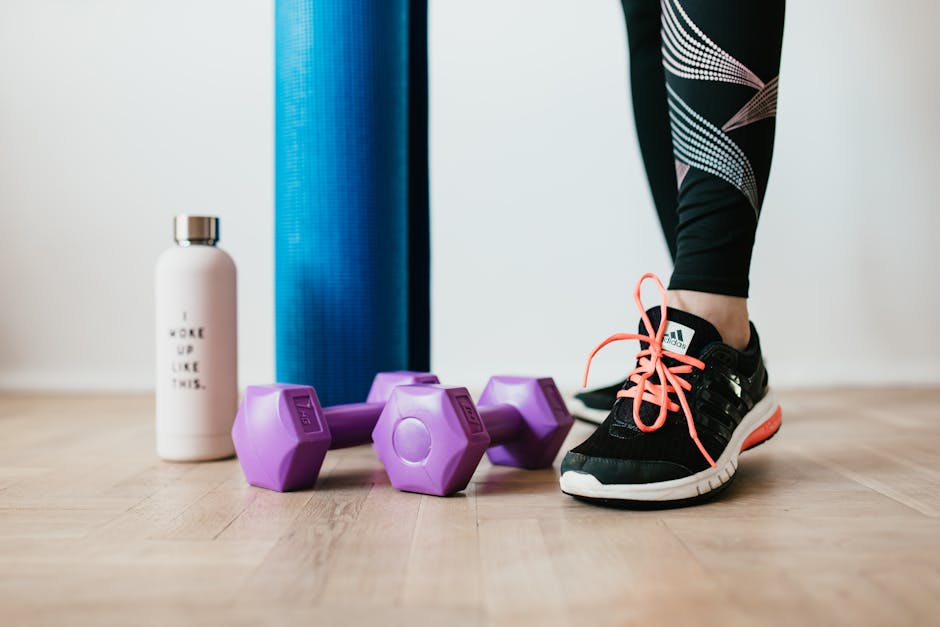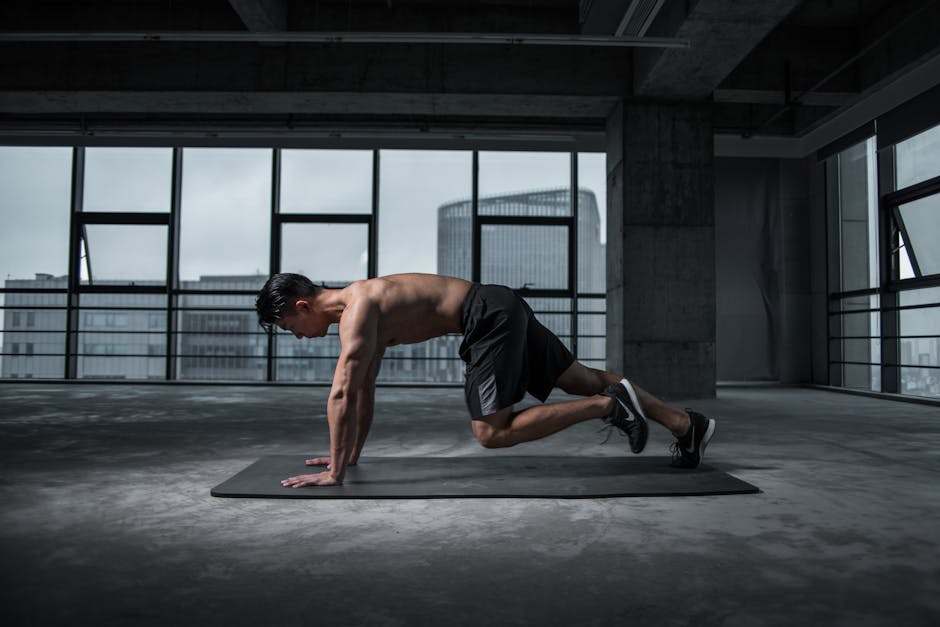How To Enhance Fitness
Published by Rich Fawthrop in Fitness the 17/08/2023 at 21:21

Health and fitness are vital components of a productive and fulfilling life. With the fast-paced and often sedentary nature of work in today's professional world, it's essential to prioritize and enhance our physical well-being. Developing a fitness routine not only boosts physical strength but also increases mental clarity , energy levels, and overall confidence. In this blog post, we will explore various strategies and techniques to help professionals like you enhance their fitness levels, regardless of their schedule or constraints. So, whether you're a busy executive, an entrepreneur, or a dedicated employee, this guide will provide you with practical tips and insights to improve your fitness and achieve a healthier, more balanced lifestyle.
Set specific fitness goals
Setting specific fitness goals is an essential step towards enhancing your fitness level. With clear objectives in mind, you can efficiently plan your workouts, track your progress, and stay motivated throughout your fitness journey.
When setting fitness goals, it is crucial to be specific about what you want to achieve. Vague goals like "getting in shape" or "losing weight" may lack the clarity necessary for measuring progress effectively. Instead, consider setting goals that are specific, measurable, attainable, relevant, and time-based (SMART goals).
To start, identify the aspect of fitness you want to focus on, whether it's improving cardiovascular endurance, building muscle strength, increasing flexibility, or losing body fat. By narrowing down your fitness goals to a specific area, you can tailor your training and nutrition plans accordingly.
Next, determine the measurable aspects of your goal. For instance, if your goal is to improve cardiovascular endurance, you may set a specific target for increasing your running distance or reducing your resting heart rate. Having measurable parameters allows you to track your progress over time, providing a sense of accomplishment and motivation.
When setting goals, be realistic and attainable. Unrealistic goals that are too far out of reach may lead to discouragement and frustration. Consider your current fitness level, lifestyle, and time constraints when setting your objectives. It's better to start with smaller, achievable goals that can be progressed over time.
Additionally, ensure your fitness goals are relevant to your overall well-being and align with your personal values. Having a clear understanding of why you want to enhance your fitness can help you stay committed and focused on your journey.
Lastly, set a timeframe for achieving your fitness goals. Having a deadline can create a sense of urgency and prevent procrastination. Breaking down long-term goals into smaller milestones with specific timeframes can also help you stay motivated and continually work towards progress .
Remember, setting specific fitness goals may require some introspection, planning, and consultation with fitness professionals. But by doing so, you will have a clear roadmap towards enhancing your fitness, resulting in a more efficient and effective workout routine.
Incorporate both cardiovascular exercises and strength training

Incorporate both cardiovascular exercises and strength training:
When it comes to enhancing your fitness levels, it is crucial to incorporate both cardiovascular exercises and strength training into your routine. While cardio workouts get your heart rate up and improve your endurance, strength training helps build lean muscle mass and increases overall strength. Together, these two forms of exercise work synergistically to elevate your fitness game and deliver optimal results.
Cardiovascular exercises, such as running, cycling, swimming, or dancing, get your heart pumping and increase your lung capacity. They improve cardiovascular health, burn calories, and promote weight loss. Engaging in at least 150 minutes of moderate-intensity cardio per week can significantly improve your overall fitness level and help reduce the risk of diseases like heart disease , obesity, and diabetes.
On the other hand, strength training involves working your muscles against resistance through activities like weightlifting, bodyweight exercises, or using resistance bands. Building strength not only enhances your appearance but also improves your daily functionality and reduces the risk of injury. Strength training can boost your metabolism, increase bone density, and improve posture, leading to better overall body composition and enhanced physical performance.
To maximize your fitness gains, it is recommended to perform a combination of both cardiovascular exercises and strength training. This means allocating specific days to focus on each form of exercise throughout the week. By diversifying your workouts, you ensure that you are targeting different muscle groups , improving cardiovascular capacity, and promoting a well-rounded fitness routine.
If you are new to exercising or unsure about where to start, it is advisable to consult with a fitness professional who can help tailor a workout plan that suits your goals and physical abilities. They can guide you on the frequency, duration, and intensity of your cardio and strength training sessions, ensuring safe and effective progress.
Remember, consistency is key when it comes to enhancing your fitness. Aim to include both cardiovascular exercises and strength training in your routine regularly. As you progress, you can gradually increase the intensity, duration, or weight to continue challenging your body and achieving new fitness milestones.
Incorporating both cardiovascular exercises and strength training into your fitness routine will not only improve your overall health but also boost your energy levels, increase your self-confidence, and enhance your overall quality of life. So, lace up your shoes, pick up those weights, and get ready to take your fitness journey to the next level.
Warm up before exercising and cool down afterwards

Photo by Cliff Booth on Pexels
Before diving into a workout or exercise routine, it is crucial to warm up your body properly in order to enhance fitness and prevent injuries. A warm-up session prepares your body for the upcoming physical activity by gradually increasing your heart rate, blood flow, and body temperature. Here are some key components of an effective warm-up routine:
1. Start with gentle cardiovascular exercises: Begin your warm-up session with low-intensity activities such as brisk walking, jogging in place, or cycling. These exercises elevate your heart rate and warm up your muscles gradually.
2. Dynamic stretches: Incorporate dynamic stretching exercises into your warm-up routine to improve flexibility and range of motion. Perform controlled movements that mimic the actions of the exercises you'll be doing during your workout. Examples include leg swings, arm circles, and walking lunges.
3. Joint mobility exercises: Pay attention to joint mobility exercises to lubricate your joints and improve their range of motion. Incorporate movements such as ankle circles, shoulder rotations, and neck rolls to warm up the specific joints that will be involved in your workout.
4. Specific movements for your workout: Tailor your warm-up routine to include movements that mimic the exercises you'll be performing during your actual workout. For instance, if you'll be lifting weights, include light sets with the respective muscle groups. If you're preparing for a running session, incorporate short bursts of jogging or high-knee lifts.
After completing your exercise routine, it is equally important to cool down your body properly. Cooling down helps your body return to its pre-exercise state gradually, reducing the likelihood of dizziness or muscle soreness. Here's how to effectively cool down:
1. Slow down gradually: After your workout, gradually decrease the intensity of your activity by slowing down your movements. For example, if you were running, start jogging or walking at a slower pace until your heart rate begins to decrease.
2. Static stretching: Perform static stretches, holding each stretch for 15-30 seconds, to promote flexibility and prevent muscle tightness. Focus on the major muscle groups that were targeted during your workout, such as hamstrings, quads, calves, and upper body muscles.
3. Deep breathing and relaxation: Take a few moments to practice deep breathing exercises and incorporate relaxation techniques into your cool-down routine. This will help calm your nervous system and lower your heart rate, aiding in recovery.
By including a proper warm-up before exercising and a thorough cool-down afterwards, you can optimize your fitness routine and reduce the risk of injury. Remember to customize your warm-up and cool-down activities based on your specific fitness level and the nature of your workout. Incorporating these essential steps into your routine will not only benefit your physical health but also contribute to a more effective and enjoyable fitness journey.
Stay hydrated during workouts

Photo by Karolina Grabowska on Pexels
Staying properly hydrated during workouts is crucial for maximizing performance and ensuring overall well -being. Sweating is a natural response to exercise, and it's essential to replenish the fluids lost to avoid dehydration. Here are five tips to help you stay hydrated during your fitness journey:
1. Drink water before, during, and after your workouts: Start your fitness routine by consuming an adequate amount of water to hydrate your body beforehand. During your workout, aim to sip water regularly, especially if you're engaging in intense or prolonged exercise. Afterward, continue drinking water to replace the fluids lost through sweating.
2. Consider electrolyte-enhanced beverages: Electrolytes are minerals such as sodium, potassium, calcium, and magnesium that play a vital role in maintaining the body's fluid balance. While water is usually sufficient for moderate workouts, if you're engaging in prolonged or intense physical activity, consider electrolyte-enhanced beverages or sports drinks to replenish both fluids and essential minerals lost through sweat.
3. Monitor your urine color: One effective way to gauge your hydration status is to pay attention to the color of your urine. Ideally, it should be a pale, straw-like color. Darker urine indicates dehydration, so make sure to increase your fluid intake if you notice a deep yellow or amber hue.
4. Be aware of environmental factors: The temperature and humidity of your workout environment can impact your hydration needs. If you exercise in hot and humid conditions, you'll likely sweat more, increasing the need for extra fluid intake. Be proactive and sip water more frequently in such situations to prevent dehydration.
5. Listen to your body: Each individual has different hydration needs, so it's important to pay attention to your body's signals. If you feel thirsty during your workout, take it as a sign that you need to drink more water. Additionally, be aware of other signs of dehydration, such as dizziness, fatigue, or dry mouth. If you experience any of these, take a break, hydrate, and allow your body to recover before resuming exercise.
Remember, maintaining proper hydration is not only crucial for enhancing your fitness performance but also for supporting overall health . By following these tips and making hydration a priority in your workout routine, you can stay energized, prevent dehydration, and reach your fitness goals with greater ease and efficiency.
Get enough sleep to aid in muscle recovery

Photo by Andrea Piacquadio on Pexels
Getting enough sleep is not only crucial for your overall health and well-being, but it also plays a significant role in enhancing your fitness levels. When it comes to building and repairing muscles, rest and recovery are just as important as exercise itself. Lack of sleep can hinder muscle recovery, making it harder for you to achieve your fitness goals.
During sleep, our body goes into a state of repair and regeneration. It is during this time that the muscles recover from the strain and damage they endure during exercise. When you don't get enough sleep, this process is disrupted, leading to slower muscle recovery and delayed progress.
One of the primary reasons why sleep is vital for muscle recovery is due to the release of growth hormones during deep sleep cycles. Growth hormones help repair and rebuild muscle tissues, making them stronger and more resilient. By ensuring you get an adequate amount of sleep each night, you provide your body with the necessary time and environment to facilitate this muscle repair process effectively.
Moreover, quality sleep also contributes to the regulation of hormones that are directly linked to muscle growth and recovery. Hormones like testosterone, cortisol, and insulin play key roles in muscle development and repair. When you consistently lack sufficient sleep , these hormone levels can become imbalanced, negatively impacting your muscle recovery and potentially hindering any progress you make during your workouts.
Additionally, sleep deprivation can lead to decreased energy levels and increased fatigue, making it harder for you to give your all during exercise sessions. When you're tired, you're more likely to skip workouts or perform at a lower intensity, which can hinder your progress and limit the effectiveness of your training.
To ensure you get enough quality sleep for improved muscle recovery, establish a consistent sleep schedule. Try to go to bed and wake up at the same time each day, even on weekends. Create a relaxing bedtime routine, avoiding stimulating activities or electronic screens before going to bed. Make sure your sleep environment is conducive to rest, with a comfortable mattress, a dark and quiet room, and a cool temperature.
Prioritizing sleep as part of your fitness routine will not only support and enhance muscle recovery but also contribute to better overall health and performance. By giving your body the rest it needs, you'll be able to maximize your efforts in the gym and achieve your fitness goals more efficiently. So, make sure to prioritize quality sleep as a key component of your fitness journey.
Find a workout routine that you enjoy and stick to it

Finding a workout routine that you enjoy and sticking to it is essential to enhancing your fitness levels and achieving your health goals. Engaging in a workout routine that sparks your interest and keeps you motivated is crucial for long-term success.
Here are some tips to help you find a workout routine that suits your preferences and ensures consistency:
1. Explore different types of workouts: Begin by exploring various workout options and determine which ones resonate with you the most. Whether it's yoga, dance, weightlifting, swimming, or running, choose activities that you genuinely enjoy.
2. Consider your preferences: Reflect on what you enjoy doing in your free time. If you love being outdoors, activities such as hiking, cycling, or rock climbing may be ideal for you. On the other hand, if you prefer being in a gym setting, weightlifting or group fitness classes might be more appealing.
3. Set clear fitness goals: Define your fitness goals to help guide you in selecting a workout routine. Whether your objective is to lose weight, improve flexibility, increase strength, or enhance cardiovascular endurance, understanding your objectives will assist you in choosing the right exercises.
4. Mix it up: Don't be afraid to mix different types of exercises and routines to keep things interesting. Engaging in a variety of activities not only prevents boredom but also offers a well-rounded fitness regimen that targets different muscle groups and promotes overall health.
5. Find an accountability partner: Consider finding a workout buddy or joining a fitness class or group. Having someone to share your journey with can keep you motivated and accountable. Plus, it can make workouts more enjoyable and create a sense of community.
6. Schedule regular workout sessions: Make exercise a priority by scheduling specific times for your workouts. Treat these sessions as non-negotiable appointments with yourself and avoid skipping them. Consistency is key when it comes to achieving fitness goals.
7. Listen to your body: It's crucial to pay attention to your body's needs and limitations. Pushing yourself too hard or neglecting proper rest can lead to burnout or injuries. Remember to incorporate rest days into your routine to allow your body to recover and rebuild.
Finding a workout routine that you enjoy and sticking to it is not only beneficial for your physical fitness but also for your mental wellbeing. It can provide a sense of accomplishment, increase your energy levels, reduce stress, and improve overall happiness.
Remember, fitness is a lifelong journey, and it's important to find activities that make you excited to engage in regular exercise. Once you find a routine that you genuinely enjoy, staying motivated and committed becomes much easier , leading to long-term success in enhancing your fitness levels.
Track your progress to stay motivated

One of the most effective ways to stay motivated on your fitness journey is by tracking your progress. When you can see how far you've come and the improvements you've made, it provides a sense of accomplishment and keeps you engaged in your fitness routine. Here are some tips on how to track your progress effectively:
1. Set attainable goals: Before you can track your progress, you need to establish clear and achievable fitness goals. Whether it's losing a certain amount of weight, running a faster mile, or completing a certain number of reps, having specific targets will help you measure your progress accurately.
2. Keep a fitness journal: Maintaining a fitness journal is an excellent way to track your workouts, nutrition, and overall progress. Write down the exercises you performed, the number of sets and reps, as well as any changes you make to your routine. Additionally, you can record how you felt during your workout, any challenges you faced, and any new accomplishments. A fitness journal not only serves as a tracking tool but also allows you to reflect on your journey.
3. Take measurements: Besides tracking weight loss or muscle gain, consider taking measurements of various body parts like waist , hips, arms, and thighs. This can provide additional insight into your progress, especially if you are focusing on body composition changes. Take measurements regularly, preferably once a month, and note any changes in your journal.
4. Use fitness apps or wearable devices: In this digital age, fitness apps and wearable devices can be valuable tools to track your progress conveniently. Apps like MyFitnessPal, Strava, or Fitbit allow you to monitor your workouts, calorie intake, and even sleep patterns. They usually provide detailed reports and graphs, making it easier to visualize your progress in real-time.
5. Periodic assessments and evaluations: Schedule regular check-ins with yourself by setting specific evaluation dates – maybe once every three months or every half-year. During these assessments, analyze your progress, review your goals, and make any necessary adjustments to your fitness plan. These evaluations are crucial for identifying areas of improvement and celebrating milestones achieved.
Remember, progress can often be more than just the numbers on a scale. It can include improvements in strength, endurance, flexibility, and overall wellbeing. By tracking your progress using various methods , you empower yourself to stay motivated, make informed decisions, and celebrate both big and small wins along the way.
Incorporate functional exercises that mimic real-life movements

Photo by Andrea Piacquadio on Pexels
Incorporate functional exercises that mimic real-life movements.
When it comes to enhancing fitness, it's important to go beyond traditional exercises and focus on functional movements that mimic real-life activities. Functional exercises engage multiple muscle groups and improve overall strength, flexibility, coordination, and balance. These types of exercises not only help in achieving better fitness results but also translate into improved performance in daily activities and prevent injuries.
One great way to incorporate functional exercises into your fitness routine is by incorporating movements that resemble the tasks you do in your day-to-day life. For example, instead of using a leg extension machine at the gym, try performing squats or lunges. These exercises mimic the movements required for activities like climbing stairs, lifting heavy objects, or bending down to pick something up from the floor.
Another functional exercise that can be easily integrated into your fitness routine is the farmer's carry. This exercise involves holding heavy dumbbells or kettlebells in each hand and walking for a certain distance. The farmer's carry helps to strengthen your grip, core muscles, and upper body, which are essential for carrying grocery bags, luggage, or other heavy objects in real life.
In addition to squats, lunges, and farmer's carries, there are various other functional exercises that can be beneficial for improving fitness. Push-ups, for instance, mimic the pushing movement required for activities like pushing open a heavy door or lifting objects overhead. Plank exercises engage the core muscles and improve stability, which is crucial for maintaining a good posture while sitting or standing for long periods.
To make your fitness routine even more functional, incorporate exercises that involve rotational movements. Exercises like Russian twists or woodchoppers engage the core and oblique muscles, which are important for tasks that require twisting or turning, such as swinging a golf club or reaching for something behind you.
Remember, when incorporating functional exercises into your fitness routine, it's essential to focus on proper form and technique. Start with lighter weights or bodyweight exercises and gradually increase the intensity as your strength and coordination improve. Consulting with a fitness professional can also be helpful in ensuring that you are performing the exercises correctly and avoiding any potential injuries.
In summary, enhancing fitness goes beyond traditional exercises and involves incorporating functional movements that mimic real-life activities. By integrating exercises like squats, lunges, farmer's carries, push-ups, planks, and rotational movements into your fitness routine, you can improve overall strength, flexibility, coordination, and balance. These functional exercises not only help in achieving fitness goals but also promote better performance in daily tasks and reduce the risk of injuries.
